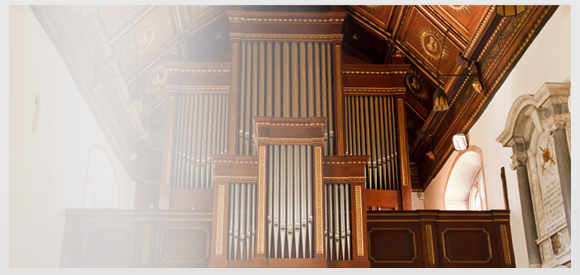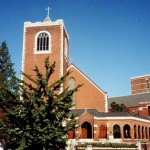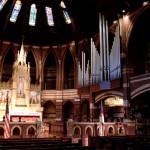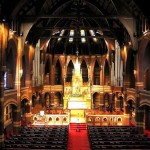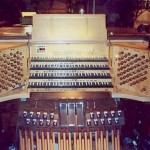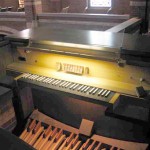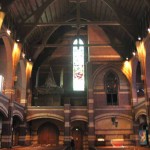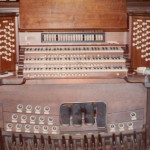St. Paul’s Episcopal Church
St. Paul’s Episcopal Church was born in January of 1853 following organizational meetings in 1852. Ten families formed the nucleus of the new church. The most influential member was Col. James A. Whiteside, a former active member of First Presbyterian Church. The first structure was a building built at the corner of 8th and Chestnut. At Colonel Whiteside’s insistence, it was replaced by a brick structure at the same site in 1868. It was used as a hospital during the Civil War and sustained serious damage. The government paid the church $3640 in damages and the congregation held their first service back in the repaired church on Thanksgiving Day 1867.
The 8th and Chestnut site was sold around 1880 for $20,000 and the church purchased the present site at 7th and Pine. The present church was built shortly thereafter. It was designed by Halsey Wood of New York City and modeled after a typical English village church. He designed similar churches in Kansas City (St. Mary’s Episcopal) and in LaCrosse, Wisconsin. The churches have striking similarities, including the altars. The church seats around 450 but seems larger due to the lofty wooden ceiling and the side galleries. It is noted for its beautiful stained glass windows.
The first organ was an Erben installed in the 1880s at a cost of $3,000. It was replaced in 1915 by Moller Op. 1986, a three-manual 41-rank instrument. In 1945, a proposal was made for a new instrument was made by Aeolian-Skinner:
The price of the organ was to be $36,000. The contract specified “the old metal pipes from the present organ to become the property of the Builder.” The contract was signed by G. Donald Harrison for the company and witnessed by Mary G. McGaffigan and Mary L. Baker. A ten-percent deposit check was mailed to Aeolian-Skinner on February 13, 1946.
The widely-believed reason for the cancellation of the contract was a dispute between the company and the organist about the design of the organ. The organist had come after the contract was signed and wanted to make changes (one would hope to the Pedal 16′ flues). GDH said no and the contract was cancelled. He then went to Moller, who was hesitant to built an organ to the revised stoplist. Ray Bradberry, the ever-practical area Moller sales rep, told the head office that the St. Paul’s organist was going to get a company somewhere to build what he wanted, and it might as well be Moller. They sighed and agreed. A large three-manual Moller of 54 ranks was installed in 1950. It was quite a successful installation, with Pedal 16′ flues that the Aeolian-Skinner stoplist lacked. An 8′ Krummhorn was added later to the Choir division. The organ was sold in 1984 to Williams Memorial United Methodist Church in Texarkana, Texas, where it was re-installed by J.C. Williams in a functional display across the front of the contemporary church. Moller built a new console for the organ in its new home.
Casavant Op. 3584 was installed in 1984, retaining from the Moller organ only the 8′ Krummhorn (which became the 16′ Ranquette in the Positif) and the 8′ Flauto Dolce and 8′ Flute Celeste in the Recit. There is a 10-rank Antiphonal division in the rear gallery, which includes its own one-manual console and Trompette-en-Chamade. In 1997, Casavant converted the console from a two-memory combination system to SSL. At this time, they also
added two 32′ Walker digital stops to the Pedal, as well as a digital 16′ Contrebasse. A III Fourniture was added to the Recit.
M. P. Moller, Opus 1986, 1915, 3/41
To quote from the announcement of the organ in the August 1915 issue of THE DIAPASON:
“William M. Jenkins of St. Louis, factory representative of M. P. Moller of Hagerstown, Md., has been awarded the contract for a large three-manual and echo organ for St. Paul’s Episcopal Church, Chattanooga Tenn. The organ is to be in memory of the soldiers of both armies who participated in the noted battles of Chickamauga, Missionary Ridge and Lookout Mountain, around Chattanooga.
“St. Paul’s church was used during the war as a hospital, and the United States government gave a sum to the church which the vestry set apart as the nucleus of a fund for the erection of a memorial organ. Consequently many builders were desirous of procuring this contract, especially as the organ is to be one of the largest in the South.”
GREAT
16′ Open Diapason
8′ 1st Open Diapason
8′ 2nd Open Diapason
8′ Grossflote
8′ Doppelflote
8′ Viole d’Gamba
8′ Gemshorn
8′ Dulciana
4′ Octave
4′ Flute Harmonique
8′ Tuba
SWELL
16′ Bourdon
8′ Open Diapason
8′ Stopped Diapason
8′ Melodia
8′ Salicional
8′ Vox Celeste
8′ Aeoline
4′ Fugara
4′ Flauto Traverso
III Dolce Cornet
8′ Cornopean
8′ Oboe
8′ Vox Humana
CHOIR
16′ Contra Viole
8′ Geigen Principal
8′ Concert Flute
8′ Dolce
8′ Unda Maris
4′ Flute d’Amour
2′ Piccolo Harmonique
8′ Clarinet
8′ Orchestral Oboe
PEDAL
16′ Open Diapason
16′ Bourdon
16′ Violone
16′ Lieblich Gedeckt
16′ Viole Dolce
8′ Octave Bass
8′ Violoncello
8′ Dolce Flute
8′ Tuba
ECHO
8′ Muted Viol
8′ Quintadena
4′ Fern Flute
8′ Vox Humana
Builder: Aeolian-Skinner Organ Co., Inc.
Year: 1945 (contract cancelled)
Opus: 1079
Console type: Detached
Stop controls: Draw knob
No. manuals: 3
No. stops: 70
No. ranks: 74
No. pipes: 4,372
Specification
GREAT
16′ Quintaten 61
8′ Principal 61
8′ Spitzprincipal 61
8′ Bourdon 61 (metal)
4′ Octave 61
4′ Rohrflote 61
2 2/3′ Quint 61
2′ Super Octave 61
IV Fourniture 244
III Cymbel 183
Chimes 25 tubes (old – new action; enclosed in CH)
SWELL
16′ Lieblich Gedeckt 73
8′ Geigen 73
8′ Rohrflote 73
8′ Viole-de-Gambe 73
8′ Viole Celeste 73
8′ Echo Salicional 73
8′ Voix Celeste 73
4′ Octave Geigen 73
4′ Flauto Traverso 73
2′ Octavin 61
III Cornet 183
VI Plein Jeu 366
16′ Bombarde 73
8′ Trompette 73
8′ Hautbois 73
8′ Vox Humana 73
4′ Clairon 73
Tremolo
Sub
Unison Release
Super
CHOIR
8′ Viola 73
8′ Viola Celeste 73
8′ Flute Triangulaire 73
8′ Aeoline 73
4′ Gemshorn 73
III Plein Jeu 183
16′ Fagot 73
8′ Krummhorn 73
4′ Rohr Schalmei 73
Tremolo
Sub
Unison Release
Super
POSITIV (floating)
8′ Cor-de-Nuit 61
4′ Koppelflote 61
2 2/3′ Nazard 61
2′ Italian Principal 61
1 3/5′ Tierce 61
1 1/3′ Larigot 61
III Zimbel 183
TOWER ROOM
8′ Diapason 49 (GG to G, playable from GT and CH Organs)
PEDAL
16′ Principal 32
16′ Gemshorn 32
16′ Quintaten GT
16′ Lieblich Gedeckt SW
8′ Principal 32
8′ Gedeckt Pommer 32
8′ Quintaten GT
8′ Gemshorn 12
8′ Viole-de-Gambe SW
4′ Choral Bass 32
4′ Nachthorn 32
2′ Blockflote 32
IV Fourniture 128
16′ Bombarde 32
16′ Fagot CH
8′ Trompette 32
8′ Krummhorn CH
4′ Clairon 32
4′ Rohrschalmei CH
Chimes GT
SOURCE: Contract and specifications provided by Paul Reynolds, organist/choirmaster of church, from church records.
M. P. Moller, Inc., Opus 8122, 1950, 3/52
GREAT
16′ Violone
8′ Principal
8′ Bourdon
8′ Spitz Principal
4′ Octave
4′ Rohrflote
2 2/3′ Quint
2′ Super Octave
IV Fourniture
Unison Off
SWELL
16′ Contra Gamba
8′ Geigen Diapason
8′ Rohrflote
8′ Salicional
8′ Voix Celeste
8′ Flauto Dolce
8′ Flute Celeste
4′ Octave Geigen
4′ Flute Triangulaire
III Cornet
IV Plein Jeu
16′ Fagotto
8′ French Trumpet
8′ Hautbois 12
4′ Clarion 12
Tremolo
Sub
Unison Off
Super
CHOIR
8′ Viole
8′ Concert Flute
8′ Dulciana
8′ Unda Maris
4′ Flauto Traverso
4′ Gemshorn
2 2/3′ Nazard
2′ Blockflote
1 3/5′ Tierce
8′ English Horn
Tremolo
Sub
Unison Off
Super
PEDAL
16′ Principal
16′ Bourdon
16′ Violone GT
16′ Gamba SW
16′ Dulciana 12
8′ Octave
8′ Bass Flute 12
8′ Violone GT
8′ Gamba SW
8′ Dulciana CH
4′ Super Octave 12
IV Mixture
16′ Bombarde
16′ Fagotto SW
8′ Trumpet SW
4′ Clarion SW
Chimes NA
NAVE
8′ Diapason Conique
8′ Cor de Nuit
4′ Octave 12
4′ Flute 12
2 2/3′ Nazard 7
2′ Flautino 5
Tremolo
Chimes from Op. 1986
TOWER
8′ Geigen Principal 41
Casavant Freres, Ltee, Opus 3584, 1984, 4/95
GRAND ORGUE
16′ Violon
8′ Montre
8′ Violon 12
8′ Bourdon
4′ Prestant
4′ Flute a Cheminee
2′ Doublette
2′ Flute
V Cornet
II-IV Grande Fourniture
VI Fourniture
16′ Bombarde
8′ Trompette
4′ Clairon
Unison Off
Clochettes
8′ Trompette-en-Chamade AN
RECIT
16′ Bourdon Doux
8′ Principal
8′ Flute Ouverte
8′ Cor de Nuit
8′ Viole de Gambe
8′ Voix Celeste
8′ Flute Douce
8′ Flute Celeste
4′ Octave
4′ Flute Octaviante
2 2/3′ Nazard
2′ Octavin
1 3/5′ Tierce
1′ Piccolo
V Plein Jeu
III Fourniture
16′ Basson
8′ Trompette Harmonique
8′ Hautbois
8′ Voix Humaine
4′ Clairon Harmonique
Tremblant
Unison Off
POSITIF
8′ Principal
8′ Voce Umana
8′ Bourdon
4′ Octave
4′ Flute a Fuseau
2 2/3′ Nazard
2′ Quarte de Nazard
1 3/5′ Tierce
1 1/3′ Larigot
V Cymbale
16′ Ranquette
8′ Trompette
8′ Cromorne
Tremblant
Unison Off
8′ Trompette-en-Chamade AN
ANTIPHONAL
8′ Montre
8′ Bourdon
4′ Prestant
4′ Flute a Cheminee
2′ Doublette
IV Fourniture
Tremblant
Chimes
8′ Trompette-en-Chamade
PEDALE
32′ Soubasse dg
32′ Bourdon dg
16′ Contrebasse dg
16′ Montre
16′ Soubasse
16′ Violon GO
16′ Bourdon Doux RE
8′ Octavebasse
8′ Bourdon
8′ Cor de Nuit RE
4′ Octave
4′ Flute
2′ Flute 12
III Theorbe —
IV Fourniture
III Cymbale
32′ Contre Bombarde 12
16′ Bombarde
16′ Bombarde GO
16′ Basson RE
8′ Trompette
8′ Hautbois RE
4′ Clairon
4′ Cromorne PO
ANTIPHONAL PEDALE
16′ Bourdon 12
